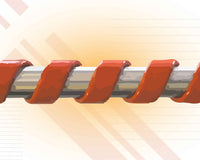In recent years, prefabricated housing has emerged as a popular and innovative solution for those seeking efficient, cost-effective, and sustainable living spaces. These homes are constructed off-site and assembled on location, offering a range of options — each catering to different needs and preferences.
However, as with any significant investment, it's important to understand the distinctions between mobile vs. manufactured vs. modular models; this is especially true regarding parts or maintenance.
Knowing the specifics helps homeowners make informed decisions, ensuring their homes remain in optimal condition. In this blog, we’ll explain the different prefabricated housing options available and the importance of understanding their unique components and maintenance requirements.
Mobile Homes

Mobile homes are prefabricated structures built in a factory and then transported to a designated site. Unlike traditional homes, mobile homes are constructed on a permanent chassis, allowing them to be moved after initial installation.
These homes are typically more affordable than site-built homes and offer a range of sizes and layouts, from single-wide units to larger double-wide models. Mobile homes are designed to be a cost-effective housing solution, providing flexibility and convenience for homeowners.
Mobile Homes Pre-1976
Before 1976, mobile homes were often referred to as "trailers" or "trailer homes." These early versions were primarily designed for mobility and temporary living, often used by travelers or seasonal workers.
The construction standards for these homes varied widely, leading to significant differences in quality and safety. Many models lacked the durability and structural integrity of modern mobile, which sometimes resulted in issues related to weather resistance, energy efficiency, and overall longevity.
HUD Code Introduction in 1976
A significant turning point came in 1976 with the introduction of the HUD Code, a set of national construction and safety standards established by the U.S. Department of Housing and Urban Development (HUD).
This code mandated specific requirements for design, construction, strength, durability, transportability, and overall quality. The implementation of the HUD Code marked a shift from the loosely regulated "trailer" era to the more standardized, reliable homes we see today.
Common Features and Construction Methods
Modern mobile homes are constructed using advanced building techniques and materials to ensure quality and durability. Common features include:
- Steel Frame: A robust steel chassis forms the foundation, providing structural support and enabling transportability.
- Insulated Walls and Roofs: Enhanced insulation materials are used to improve energy efficiency and comfort.
- Prefabricated Sections: Homes are built in sections or modules in a controlled factory environment for precision and consistency.
- Standardized Plumbing and Electrical Systems: These systems are installed according to strict codes to ensure safety and functionality.
- Customizable Interiors: Homeowners can choose from various floor plans, finishes, and fixtures to personalize their living space.
Manufactured Homes

Manufactured homes are another type of prefabricated housing that is built in a factory and then transported to a permanent site.
Difference Between Mobile and Manufactured Homes
While the terms "manufactured homes" and "mobile homes" are often used interchangeably, there are a few key differences between the two. The term "mobile home" typically refers to homes built before 1976, before the implementation of the HUD Code.
Manufactured homes, on the other hand, are those constructed after 1976 and are built to meet stringent federal standards set by the HUD. This distinction is very important when considering replacement parts for mobile homes vs. manufactured homes.
Construction Process and Materials
The construction of manufactured homes takes place in a controlled factory environment, which offers several advantages over traditional site-built construction. The process typically involves the following steps:
1 - Design and Planning: Detailed plans are created, specifying the layout, materials, and features of the home.
2 - Frame Construction: A robust steel frame is built to provide structural support and ensure transportability.
3 - Assembly: The home is assembled in sections or modules, with walls, floors, and roofs constructed using high-quality materials. Advanced techniques and precision tools are used for consistency.
4 - Systems Installation: Plumbing, electrical, and HVAC systems are installed according to strict codes and standards.
5 - Finishing Touches: Interior finishes, such as flooring, cabinetry, and fixtures, are added to complete the home.
Transportation and Installation
Once the construction of a manufactured home is complete, it is transported to its permanent site. The transportation process involves several key steps:
1 - Preparation: The home is securely fastened to its steel chassis and prepared for transport.
2 - Transport: Specialized trucks and trailers are used to move the home to its destination. The route is carefully planned to ensure safe and efficient delivery.
3 - Site Preparation: The site is prepared with a foundation, utilities, and any necessary permits.
4 - Installation: The home is placed on its foundation and securely anchored. Final connections for plumbing, electrical, and HVAC systems are made, and any necessary inspections are conducted.
Modular Homes

Unlike manufactured homes (which are built on a permanent chassis), modular homes are constructed to the same building codes as traditional site-built homes and are placed on permanent foundations.
This method of construction offers several advantages, including faster build times, reduced waste, and often lower costs. Modular homes can also be customized to meet a wide range of design preferences. When comparing mobile vs. modular home options, it's integral that homeowners consider these features.
Building Codes and Standards (IRC, IBC)
Modular homes must comply with the same local, state, and regional building codes as site-built homes. In the United States, this typically means adhering to the International Residential Code (IRC) for one- and two-family dwellings or the International Building Code (IBC) for multi-family and commercial buildings.
These codes cover all aspects of construction, including structural integrity, fire safety, energy efficiency, and plumbing or electrical systems. Compliance with these codes ensures that modular homes meet the same safety and quality standards as traditional homes, providing peace of mind for homeowners.
Construction Process and On-Site Assembly
The construction of modular homes involves several key steps:
1 - Design and Planning: Detailed architectural plans are created, specifying the layout, materials, and features of the home. These plans must comply with local building codes and standards.
2 - Factory Construction: Modules are built in a controlled factory environment. This includes framing, insulation, plumbing, electrical wiring, and interior finishes. The factory setting allows for precise construction and quality control.
3 - Transportation: Once the modules are complete, they are transported to the home site. Specialized trucks and trailers are utilized.
4 - Site Preparation: The home site is prepared with a foundation, utilities, and any necessary permits. This step is crucial for ensuring a smooth assembly process.
5 - On-Site Assembly: The modules are craned into place and securely fastened together. Final connections for plumbing, electrical, and HVAC systems are made, and any necessary inspections are conducted.
6 - Finishing Touches: Exterior finishes, such as siding and roofing, are completed. Any interior touch-ups are then made to ensure the home is move-in ready.
Customization Options
One of the significant advantages of modular homes is the ability to customize the design to meet individual preferences and needs. Homeowners can choose from a wide range of floor plans, architectural styles, and interior finishes. Customization options may include:
- Floor Plans: From single-story ranch designs to multi-story homes, modular homes can be tailored to fit various layouts and sizes.
- Exterior Finishes: Options for siding, roofing, windows, and doors allow homeowners to create a unique exterior appearance.
- Interior Features: Customizable options for flooring, cabinetry, countertops, fixtures, and appliances enable homeowners to personalize their living spaces.
- Energy Efficiency: Homeowners can opt for energy-efficient features such as advanced insulation, high-performance windows, or energy-efficient HVAC systems.
Regulations for Manufactured and Modular Homes
As we mentioned earlier, manufactured and modular homes are each regulated by different building codes. Here are a few key standards to keep in mind.
HUD Code Regulations for Manufactured Homes
Energy Efficiency Requirements
The HUD Code includes stringent energy efficiency requirements to make certain that manufactured homes are not only comfortable but also cost-effective to live in. These requirements cover aspects such as insulation, windows, and heating or cooling systems. By adhering to these standards, manufacturers provide homes that maintain a consistent indoor temperature, reduce energy consumption, and lower utility bills for homeowners.
Wind Resistance Standards
Manufactured homes must also meet specific wind resistance standards to ensure they can withstand severe weather conditions. The HUD Code categorizes homes into different wind zones, each with its own set of requirements.
For instance, homes in coastal areas (which are more prone to events like hurricanes), must be built to higher wind resistance standards compared to those in inland areas.
Fire Safety Regulations
Manufactured homes must be constructed with fire-resistant materials and include features such as smoke detectors and escape windows. These regulations are designed to minimize the risk of fire while ensuring that occupants have adequate warning — and means of escape — in the event of an emergency.
IRC and IBC for Modular Homes
Local Building Code Compliance
One of the key requirements for modular homes is compliance with local building codes. These codes can vary significantly from one jurisdiction to another, covering everything from structural integrity to electrical systems and plumbing.
Modular home manufacturers must ensure that their homes meet all applicable local codes, which often means working closely with local building officials during the design and construction process. This compliance ensures that modular homes are safe, durable, and suitable for the specific location where they will be placed.
Site-Specific Requirements
In addition to general building codes, modular homes must also meet site-specific requirements. These can include considerations such as soil conditions, climate, and local zoning laws.
For example, a modular home built in a seismic zone must be designed to withstand earthquakes, while one in a flood-prone area must be elevated above the base flood elevation.
Mobile Vs. Manufactured Vs. Modular Parts: Shopping for the Right Components

When it comes to maintaining or upgrading your home, finding the right replacement parts can seem like a daunting task. Before you begin shopping, you must first understand two things: how to identify your home type and how to determine which components are compatible with your model.
Identifying Your Home Type
Identifying your model will help you find the correct parts that are compatible with your home’s specific requirements.
VIN Number for Manufactured Homes
For manufactured homes, the Vehicle Identification Number (VIN) is a critical piece of information. The VIN is typically located on the data plate, which can be found inside a cabinet, closet, or electrical panel. This number provides essential details about your home, such as the manufacturer, model, and year of production. Having this information handy will make it easier to find parts that are specifically designed for your home.
Data Plate Information
The data plate in your home contains a wealth of information that can be invaluable when shopping for parts. This plate includes details such as the wind zone, roof load, and thermal zone ratings, which are important for ensuring that any parts you purchase are suitable for your home’s specific conditions.
For example, if you live in a high-wind area, you'll need parts that can withstand those conditions. Always refer to the data plate to verify that the parts you are considering are compatible with your home’s specifications.
Compatibility of Parts Across Home Types
One of the most important aspects of shopping for home parts is ensuring compatibility. Manufactured and modular homes have different construction standards, so parts are not always interchangeable.
Remember that manufactured homes are always built to the HUD Code, which means that parts must meet specific federal standards. When shopping for parts, look for those that are HUD-approved to be sure they will work with your home.
Modular homes are built to local building codes, which can vary significantly. Parts for modular homes need to comply with the IRC or IBC, as well as any local amendments. Always check with your local building authority if you are unsure!
Common Misconceptions When Purchasing Parts
Several misconceptions can lead to purchasing the wrong parts for your home. Being aware of these can save you time, money, and frustration.
"All Parts Are Universal"
One common misconception is that parts are universal and can be used in any type of home, but this simply is not true. Manufactured and modular homes have different construction standards, and using the wrong parts can lead to safety issues or code violations.
"Cheaper Is Always Better"
While it might be tempting to go for the cheapest option, this can be a costly mistake in the long run. Cheaper parts may not meet the necessary standards for your home, leading to potential failures and additional expenses down the line. Always prioritize quality and compatibility over price.
"Local Stores Have Everything I Need"
While local hardware stores can be convenient, they may not always carry the specific parts required for manufactured or modular homes. Certain parts often need to be ordered from manufacturers or specialized suppliers like Star Mobile. Don’t assume that just because a part is available locally, it is the right fit for your home.
Find the Perfect Fit with Star Mobile
Ready to find the perfect replacement parts for your home? Our team is always here to assist you in identifying the correct parts for your home. Browse our extensive inventory of mobile home parts today!






